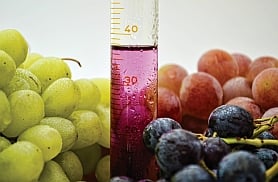The health benefits and drawbacks of wine consumption are confused by numerous myths and half-truths. Herewith, a few choice FAQs from the wine column grab bag.
Q: Should I be concerned about the use of sulphur in winemaking?
Next time you pick up a bottle of wine, have a look at the back label. It will probably include the warning “Contains Sulphites.” Sulphur products are used in winemaking – especially at the time of bottling – as anti-oxidant and anti-bacterial agents, particularly for white wines. They are needed to stabilize colour, keep the wine clean and give the product shelf life.
But even wines that are made without sulphur will contain sulphites, since the very act of fermentation creates sulphur dioxide, some of which will bind chemically with the wine. Even wines that have never been treated with sulphur will contain concentrations of up to 10 milligrams per litre of SO2. (The same is true for foodstuffs that are fermented, like cheeses and sauerkraut. And you can be sure that sulphur products are used to preserve fresh fruits, dried fruits, vinegar, juices, soft drinks, sauces, beer, as well as wines.)
Logically then, the back labels on wine bottles should read: “Guaranteed to Contain Sulphites.” EU wine laws have come to terms with this irony by regulating that any wine with more than 10 millilitres per litre of sulphur dioxide must carry the warning that the wine contains sulphites.
Most consumers can’t sense the presence of sulphites on the nose or the palate at twice this level and it’s only at above 30 milligrams per litre that experienced tasters can detect the “burnt match head” odour that signals the presence of SO2. White, rosé and particularly sweet wines tend to have higher levels of sulphur than reds.
The World Health Organization has set guidelines for the safe ingestion of sulphur dioxide, recommending a daily intake of no more than 0.7 grams per kilogram of body weight. For men of average weight, this computes to less than a third of a bottle of a white wine with a concentration of 200 milligrams per litre (the EU limit for dry white wine is 210 milligrams per litre, though that figure may be high given winemakers’ desire these days to limit the amount of sulphites they use.)
Sulphur dioxide may cause allergic reactions in some people, especially if one suffers from asthma. Unfortunately, there is no way to tell the amount of SO2 in a given wine but there will always be some. And given modern winemaking techniques and the sensitivities winemakers have around the use of sulphur products – with the move to organic and biodynamic wine growing – there will continue to be less sulphites in wine.
Q: Why does my face flush when I drink a glass of wine?
There are a few reasons: you could be reacting to the sulphites in the wine or to the alcohol — or you could have a medical condition known as rosacea. Alcohol makes the blood vessels expand, and heavy drinking can cause a condition called Alcohol Telangiectasia, which manifests itself as broken capillaries rendered visible as a network of red spider veins.
Alcoholic flush happens to people who lack enough of the enzyme alcohol dehydrogenase (ADH), which converts alcohol to acetaldehyde. It’s the accumulation of acetaldehyde that causes the flushing, usually accompanied by swelling of the skin, giddiness and headaches. I have heard that taking heartburn remedies like Zantac or Pepcid before you ingest alcohol could alleviate the problem; and it could solve the problem of those who get headaches from the histamines in red wine. (I am no doctor, so consult your physician before taking any remedies if you’re taking alcohol in any form.)
Rosacea is commonly found in fair-skinned people between the ages of 30 and 50 and is three times more common in women. Apart from environmental factors, facial flushing can be caused by stress, caffeine in tea and coffee, spicy foods, especially those high in histamines, and of course, alcohol. While there is no cure as such, the condition can be controlled with medical therapy and lifestyle changes. Rosacea sufferers can take cold comfort from the fact that they share the condition with former President Bill Clinton, the late Princess Diana, financier J.P. Morgan and the Dutch painter Rembrandt.
Q: Does wine make me fat?
First, let us dispel the myth that red wine is particularly heavy. In truth, red wine is no more fattening than white. It’s the amount of alcohol in conjunction with the residual sugar in the wine that determines the number of calories per glass. In determining the number of calories per pour, a rough estimate is 25 calories for every 30 millilitres. So the average bottle of wine will contain 650 calories. Sweet wines will be higher. A six-ounce glass of dry red or white wine with 13 per cent alcohol will contain up to 160 calories, which is in the same ballpark as a generous slice of Madeira cake. So, the choice is yours.
Tony Aspler is the author of 17 books on wine, including his latest, Canadian Wineries.
Q: Should I be concerned about the use of sulphur in winemaking?
Next time you pick up a bottle of wine, have a look at the back label. It will probably include the warning “Contains Sulphites.” Sulphur products are used in winemaking – especially at the time of bottling – as anti-oxidant and anti-bacterial agents, particularly for white wines. They are needed to stabilize colour, keep the wine clean and give the product shelf life.
But even wines that are made without sulphur will contain sulphites, since the very act of fermentation creates sulphur dioxide, some of which will bind chemically with the wine. Even wines that have never been treated with sulphur will contain concentrations of up to 10 milligrams per litre of SO2. (The same is true for foodstuffs that are fermented, like cheeses and sauerkraut. And you can be sure that sulphur products are used to preserve fresh fruits, dried fruits, vinegar, juices, soft drinks, sauces, beer, as well as wines.)
Logically then, the back labels on wine bottles should read: “Guaranteed to Contain Sulphites.” EU wine laws have come to terms with this irony by regulating that any wine with more than 10 millilitres per litre of sulphur dioxide must carry the warning that the wine contains sulphites.
Most consumers can’t sense the presence of sulphites on the nose or the palate at twice this level and it’s only at above 30 milligrams per litre that experienced tasters can detect the “burnt match head” odour that signals the presence of SO2. White, rosé and particularly sweet wines tend to have higher levels of sulphur than reds.
The World Health Organization has set guidelines for the safe ingestion of sulphur dioxide, recommending a daily intake of no more than 0.7 grams per kilogram of body weight. For men of average weight, this computes to less than a third of a bottle of a white wine with a concentration of 200 milligrams per litre (the EU limit for dry white wine is 210 milligrams per litre, though that figure may be high given winemakers’ desire these days to limit the amount of sulphites they use.)
Sulphur dioxide may cause allergic reactions in some people, especially if one suffers from asthma. Unfortunately, there is no way to tell the amount of SO2 in a given wine but there will always be some. And given modern winemaking techniques and the sensitivities winemakers have around the use of sulphur products – with the move to organic and biodynamic wine growing – there will continue to be less sulphites in wine.
Q: Why does my face flush when I drink a glass of wine?
There are a few reasons: you could be reacting to the sulphites in the wine or to the alcohol — or you could have a medical condition known as rosacea. Alcohol makes the blood vessels expand, and heavy drinking can cause a condition called Alcohol Telangiectasia, which manifests itself as broken capillaries rendered visible as a network of red spider veins.
Alcoholic flush happens to people who lack enough of the enzyme alcohol dehydrogenase (ADH), which converts alcohol to acetaldehyde. It’s the accumulation of acetaldehyde that causes the flushing, usually accompanied by swelling of the skin, giddiness and headaches. I have heard that taking heartburn remedies like Zantac or Pepcid before you ingest alcohol could alleviate the problem; and it could solve the problem of those who get headaches from the histamines in red wine. (I am no doctor, so consult your physician before taking any remedies if you’re taking alcohol in any form.)
Rosacea is commonly found in fair-skinned people between the ages of 30 and 50 and is three times more common in women. Apart from environmental factors, facial flushing can be caused by stress, caffeine in tea and coffee, spicy foods, especially those high in histamines, and of course, alcohol. While there is no cure as such, the condition can be controlled with medical therapy and lifestyle changes. Rosacea sufferers can take cold comfort from the fact that they share the condition with former President Bill Clinton, the late Princess Diana, financier J.P. Morgan and the Dutch painter Rembrandt.
Q: Does wine make me fat?
First, let us dispel the myth that red wine is particularly heavy. In truth, red wine is no more fattening than white. It’s the amount of alcohol in conjunction with the residual sugar in the wine that determines the number of calories per glass. In determining the number of calories per pour, a rough estimate is 25 calories for every 30 millilitres. So the average bottle of wine will contain 650 calories. Sweet wines will be higher. A six-ounce glass of dry red or white wine with 13 per cent alcohol will contain up to 160 calories, which is in the same ballpark as a generous slice of Madeira cake. So, the choice is yours.
Tony Aspler is the author of 17 books on wine, including his latest, Canadian Wineries.





